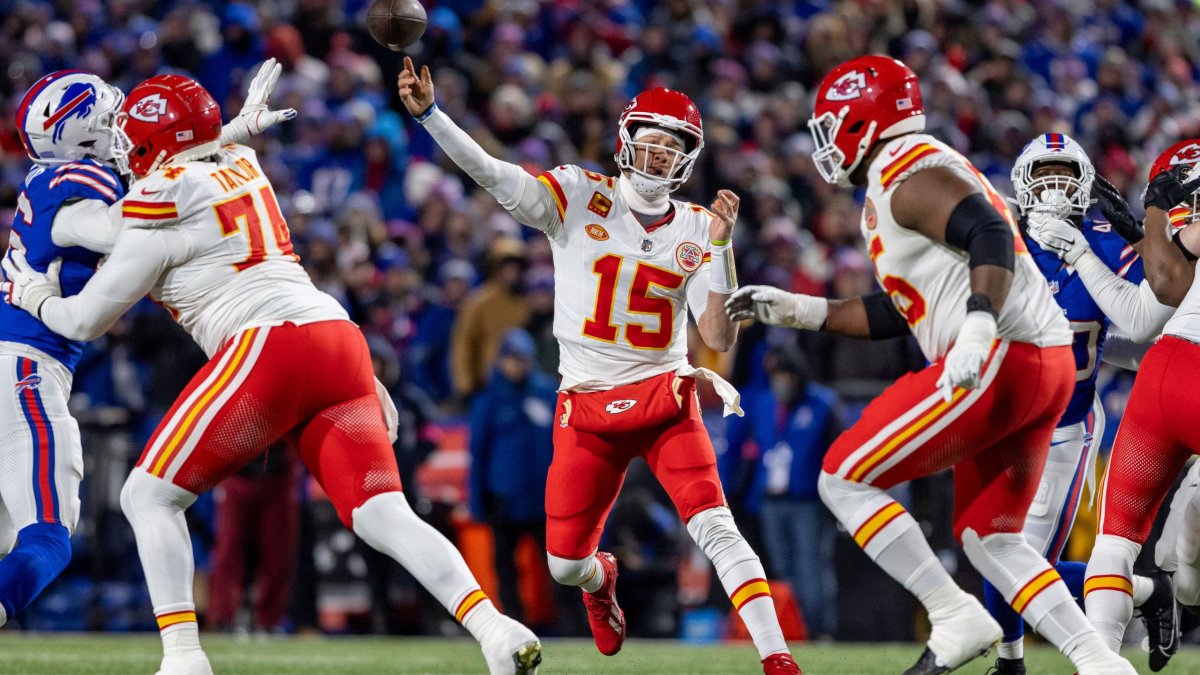• Adapt or die: Patrick Mahomes has made various adjustments throughout his career, and within his Super Bowl victories, that showcase his versatility and greatness..
• The loss: His Super Bowl loss to the Tampa Bay Buccaneers exposed the Kansas City Chiefs’ flaws up front and the following offseason has been a catalyst in their dynastic run.
• San Francisco 49ers need better defense: Given Mahomes' propensity for playing his best in big moments, the 49ers will need to play better defensively than they have recently.
Estimated Reading Time: 8 minutes
Patrick Mahomes already boasts an incredible legacy that now includes four AFC titles and at least two Super Bowl victories in just six years as a starter.
His poise in the biggest moments stands out as one of his best traits, and there are times when an otherworldly performance feels inevitable. Mahomes’ previous Super Bowl appearances, though, haven’t come without their share of adversity, including in the first matchup against the San Francisco 49ers.
We’ll take a look at each of his previous appearances while also looking ahead to this Sunday’s rematch with San Francisco.
Super Bowl LIV vs. San Francisco 49ers
Facing the league’s best coverage unit headlined by future Hall of Famer Richard Sherman, Mahomes struggled mightily through three-plus quarters and faced a 10-point deficit late against San Francisco.
In what has now become typical Mahomes fashion, he found his A-game just in time to secure a victory.
- First 50 minutes: 18/29, 172 yards. 0 TD, 2 INT, 0 BTT, 4 TWP
- Last 10 minutes: 8/13, 114 yards, 2 TD, 2 BTT, 0 TWP
It appeared as though Mahomes’ first Super Bowl appearance would be marred by his struggles against an elite 49ers defense. He threw a bad interception directly into the chest of linebacker Fred Warner. His mediocre 63.7 PFF game grade was partially dragged down by two fumbles that San Francisco was unable to recover.
At the crux of Mahomes’ struggles in that game were two things — San Francisco’s excellent pass rush and the team's use of quarters coverage.
Mahomes was under duress on 41.2% of his dropbacks in that game and finished with a 46.9 PFF passing grade in those situations. He also committed all four of his turnover-worthy plays under pressure.
The 49ers also deployed quarters coverage nearly half of the time against Mahomes in that game. Mahomes, at times, was uncomfortable with having to make more conservative decisions due to the secondary playing four-deep coverage so often.
He posted a 49.7 PFF passing grade against quarters as opposed to a 71.7 PFF passing grade against all other coverages.
As it turned out, Mahomes had to take advantage when he was able to see single-high coverages. He did so by making one of the most iconic throws of his career.
That throw was the catalyst to a victory that night and to what is now the premier dynasty in the NFL.
Super Bowl LV vs. Tampa Bay Buccaneers
Mahomes’ lone Super Bowl defeat still stands as the second-most lopsided loss of his career. Simply put, the story of that 31-9 loss was the difference in pass protection.
Kansas City was missing three of its opening-day starters on the offensive line due to injury as well as a fourth who was playing out of position. That left center Austin Reiter as the only starter who was playing his natural position.
Facing an excellent group of pass rushers that included Shaquil Barrett, Vita Vea, and Devin White, Kansas City’s front stood no chance.
Mahomes was under pressure at an untenable 55.4% rate over the course of the game. The offensive line was charged with an astounding 30 pressures.
As a result, Kansas City posted a 42.2 PFF pass-blocking grade in that game — the worst mark that PFF has recorded in a Super Bowl, though that record was broken the next year when the Cincinnati Bengals were shredded up front by Aaron Donald and the Los Angeles Rams.
Mahomes made both of his big-time throws under pressure but completed just nine of his 26 passes and was sacked three times. In total, Mahomes finished his night with a pedestrian 61.2 PFF passing grade and two interceptions.
Contrast that with the protection Tom Brady got and the disparity in the final score makes total sense. Aided by Brady’s lightning-quick 2.16-second average time to throw, Tampa Bay’s offensive line allowed just four pressures among 30 dropbacks.
Brady responded in kind, using a conservative, play-action-heavy game plan to systematically work his way down the field against the Chiefs’ defense. When given a clean pocket, Brady completed 21 of his 26 passes and finished the game with a 73.6 PFF clean pocket passing grade.
Obviously, most people don’t like to make excuses for elite players, but no quarterback, not even Mahomes, is likely to overcome a 55% pressure rate.
That loss, though, made immediately clear what Kansas City needed to do in the offseason. They amazingly started the 2021 season with five new starters up front, including stud rookies Creed Humphrey and Trey Smith. It could be argued that that offseason is the biggest reason, outside of Mahomes, that the Chiefs are such a consistent force.
Super Bowl LVII vs. Philadelphia Eagles
Two years after the loss to Tampa Bay, Kansas City’s rebuilt offensive line faced the ultimate test against an Eagles defense that finished the regular season with the third-most sacks in NFL history.
For the most part, that unit was up to the task. Right guard Trey Smith struggled, allowing five of the group’s ten pressures, but every other Chiefs player finished with a pass-blocking grade of at least 65. They also did not allow a sack.
That’s certainly commendable given that Philadelphia was by far the best pass-rushing team in football last season.
Given more time to operate than his previous Super Bowl appearance, Mahomes was absolutely dominant.
Patrick Mahomes Clean Pocket Stats, Super Bowl LVII
| Overall Grade | 93.2 |
| Passing Grade | 89.0 |
| Completion % | 94.4% |
| Yards per Attempt | 8.0 |
| Passing TDs | 3 |
Mahomes went 17-for-18 from a clean pocket and made his lone big-time throw of the day on his first touchdown of the day to Travis Kelce.
This game showcased Mahomes’ newfound ability, with some schematic help, to win in a more conservative manner. This adjustment was necessary given the trade of Tyreek Hill to the Miami Dolphins, and though the Chiefs got future All-Pro cornerback Trent McDuffie through that trade, Mahomes had to reinvent himself along the way.
Mahomes attempted just two passes at least 20 yards downfield and didn’t complete either. However, the second incompletion, which isn’t considered official, drew the infamous holding penalty on James Bradberry that sealed the game.
Given Mahomes' knack for making big plays in his career, it seems odd that Mahomes put up over 30 points without completing any deep shots. Philadelphia’s elite pair of cornerbacks, Bradberry and Darius Slay, was a problem on the outside. Naturally, Mahomes steered away from them.
Mahomes completed 15 of his 17 passes, including all nine in the second half, inside the numbers for 125 yards. Most of Mahomes’ best throws were completed just behind Philadelphia’s linebackers and slot cornerbacks. It’s surely an area that he and Andy Reid emphasized in the time leading up to the game.
Mahomes needed every bit of his marvelous prowess to beat Jalen Hurts, whose 92.9 PFF passing grade in that game was the best the PFF has ever recorded in a Super Bowl.
Mahomes’ adjustments with a rebuilt offensive line and a Tyreek Hill-less receiving corps allowed him to win his second Super Bowl in four seasons.
Can Mahomes beat San Francisco again?
In short, absolutely. He’s Patrick Mahomes.
San Francisco, despite its lopsided loss to Baltimore, may have rather seen the Ravens in this matchup given Mahomes dominance over them in their previous matchups.
In Kansas City’s previous three matchups with the 49ers, the Chiefs have scored 37.7 points per game. Their most recent meeting with Kansas City in 2022 resulted in Mahomes throwing for 423 yards and 3 touchdowns.
San Francisco’s two lowest-graded defensive games since 2018 have come against Kansas City. Even though that unit performed better in their first Super Bowl matchup, the 49ers still finished the game with a shaky 57.0 PFF grade, which was their second-worst of that season.
The tough matchup with Mahomes along with San Francisco’s recent defensive struggles could be a huge problem for the 49ers.
49ers Defensive Grades since Week 15
| Overall Grade | 61.6 | 28th |
| Run Defense Grade | 47.4 | 29th |
| Pass Rush Grade | 65.5 | 19th |
| Coverage Grade | 68.9 | T-12th |
San Francisco’s stars like Nick Bosa and Fred Warner have continued to perform well, but many of the ancillary players have struggled of late defending the run and subsequent play-action pass.
The 49ers need a dramatic turnaround in performance from their defense if they are going to thwart Mahomes this time.




 © 2024 PFF - all rights reserved.
© 2024 PFF - all rights reserved.